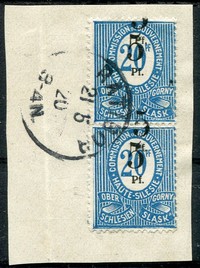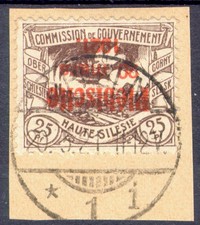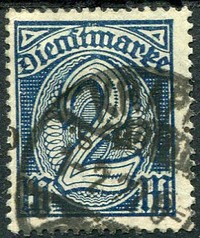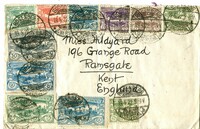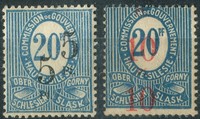Upper Silesia
The Versailles peace treaty planned to award most of Silesia (except a western strip adjoining Germany) to Poland. However the German population was more evident in the main towns throughout Silesia, dominating business and industry, even though a minority in terms of sheer head count. Among the participants in the peace treaty, the English recognised that a plebiscite was the only way to resolve the conflict. From 12th February 1920 to 14th June 1922 an Allied Commission set about civil administration and organising the plebiscite.
The French 46th Infantry Division and the 22nd Alpine Battalion maintained military order, although attempted insurrections or disturbances took place. Stampless mail from this occupying force can be recognised from use of a military mail TRESOR ET POSTES cancel and sender's mention of the field post office section S.P.184.
Special stamps for use in the plebiscite area were ordered from France, and intended to be available for use from the first day of plebiscite administration on 12th February 1920. Owing to delays, the special stamps only became available on 20th February. Therefore, for nine days, any Germany stamps in the hands of the public, or remaining in post offices, were permitted to be used for this brief emergency period. Identifiable German stamps with clear town name and correctly dated postmark have a specialist market value of around £300 as single stamps, or (easier to certify) around £1000 on cover.
1920 SURCHARGES (018877)
- Price
- £10.00
- Stock Code
- 018877
5pf/20pf (Mi 10) vertical pair, both with double overprint, used on piece with RATIBOR cds
1921 PLEBISCITE OVPT (021865)
- Price
- £150.00
- Stock Code
- 021865
25pf (Mi 33) error overprint inverted, used on piece with OPPELN cds
OFFICIALS (021521)
- Price
- £5.00
- Stock Code
- 021521
2M (without 21) wmk lozenge (Mi 19), ovpt C.G.H.S. inverted, used
1920 DOVES (026094)
- Price
- £20.00
- Stock Code
- 026094
1920 DOVES (026094)
11 various Doves issue to 75pf on cover (philatelic) from ROSENBERG cds to Ramsgate, UK, 1922
1920 SURCHARGES (026303)
- Price
- £20.00
- Stock Code
- 026303
1920 SURCHARGES (026303)
5pf on 20pf and 10pf on 20pf, both with double overprint mint light hinge

